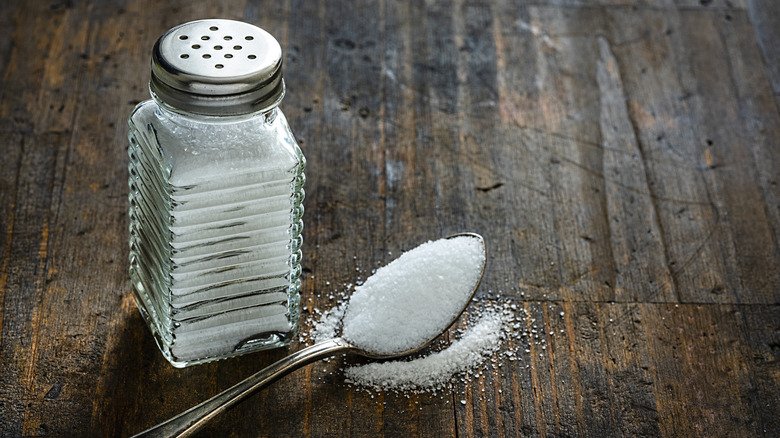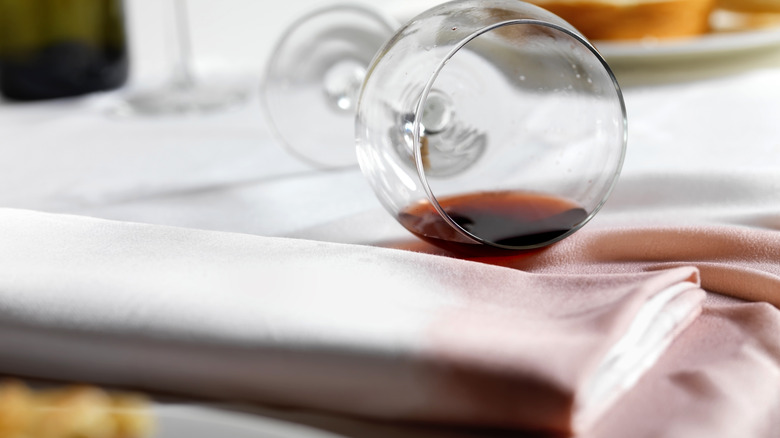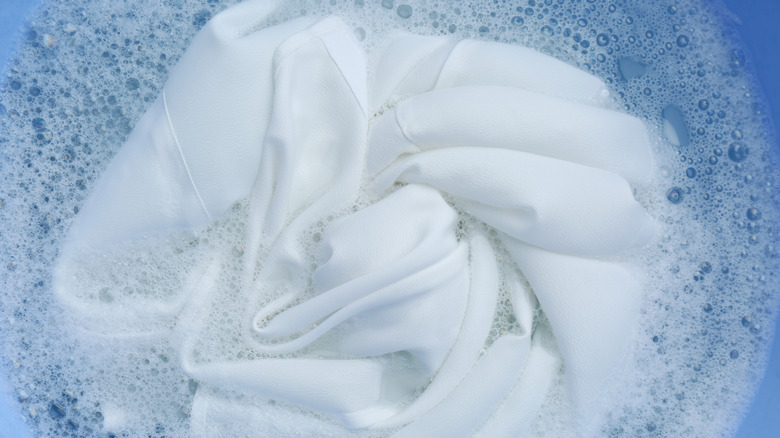The Common Salt Stain Remover Myth You Should Stop Believing
You may reach for salt to add flavor to an otherwise bland meal, but there are some pretty interesting household uses for it that have nothing to do with consumption. Perhaps your grandmother used to swear that salt was the go-to cleaning agent from back in the day. It does work as a stain remover, pulling rust marks out of fabric and pulling out yellowed spots from dirt on those white baseball pants. While it can work in these ways to remove the toughest fabric stains, though, it should not be your go-to solution in all cases.
Salt works because it dehydrates the liquid from the stain, absorbing all of the fluid to prevent it from penetrating the fabric's fibers. That could indicate that when someone spills a glass of red wine on your vintage tablecloth you wouldn't dare bleach, all you have to do is reach for the saltshaker. Think again, however. Salt will not help in this situation in the way you need it to.
Salt will capture the moisture, soaking up much of the liquid itself, but it cannot help with the real problem here: the red coloring from the wine. The time you spend trying to use salt could be better put to use with alternative, more effective red wine stain removal methods. Whether it's the carpeting you just installed or that beautiful tablecloth, don't make the mistake of trusting salt as a solution.
Why salt doesn't really help remove red wine
Salt seems like the ideal solution because it's readily available and absorbent. The belief is that pouring salt onto the red wine will allow the liquid to immediately absorb into the salt, allowing you to just brush it away. Here's the problem. Salt will absorb the liquid, yes, but it's most likely to leave behind the big problem: the red coloring. It's this dye that's going to be the big problem for you, creating the hard-to-remove stain. Yet, the salt will actually cause the dye to set.
If you've ever had the opportunity to do some tie-dying or you've dyed fabric for a project, you may have already seen the work salt does. Salt helps to set the dye, aiding in pulling the coloring into the fabric so it sets (that's one of the reasons salt works well in the laundry to help prevent clothing from fading). Salt works to support the movement of dye into the fabric and then encourages it to hold onto the fibers, creating the desired color. Now, think about that. If salt helps to set the color in the fabric, and red wine has that red color in it, you're only encouraging the stain to set, not releasing it. More so, salt isn't going to stay in a dry, easy-to-brush-off form. As it sucks up the liquid, it's going to dissolve and thicken, and that's no easier to clean off than the actual red wine.
What you should do with a red wine stain, instead
Since salt isn't an ideal red wine stain remover, what should you do? The simplest option is to move fast. Blot up the fluid initially by applying gentle pressure to it. Use an absorbent cloth for this. That helps to control the transfer of fluid, much like salt would have done. Then, you'll need to tackle the remaining stain.
There are various strategies you can try to remove red wine from fabric. One of the options involves creating a mixture of hydrogen peroxide and liquid soap to apply directly to the stain. Hydrogen peroxide helps with various stubborn household stains as a chemical cleaning agent, working to break the bond the stain has on the fabric and helping to get rid of the color. In this way, hydrogen peroxide acts like a mild bleach, but one that's not too intense to damage the fabric itself. The soap helps to increase that functionality.
To do this, aim for a 3:1 ratio, with hydrogen peroxide being the main component. Any type of mild dish detergent without bleach or added abrasive compounds will work. After mixing, apply directly to the stain and allow it to sit for up to 20 minutes (don't allow it to dry). Then, rinse it out to see the improvement. You can use this method on most fabrics, but for those delicate items, test a small corner first. You should see the stain fading away and your linens beautifully white again.


